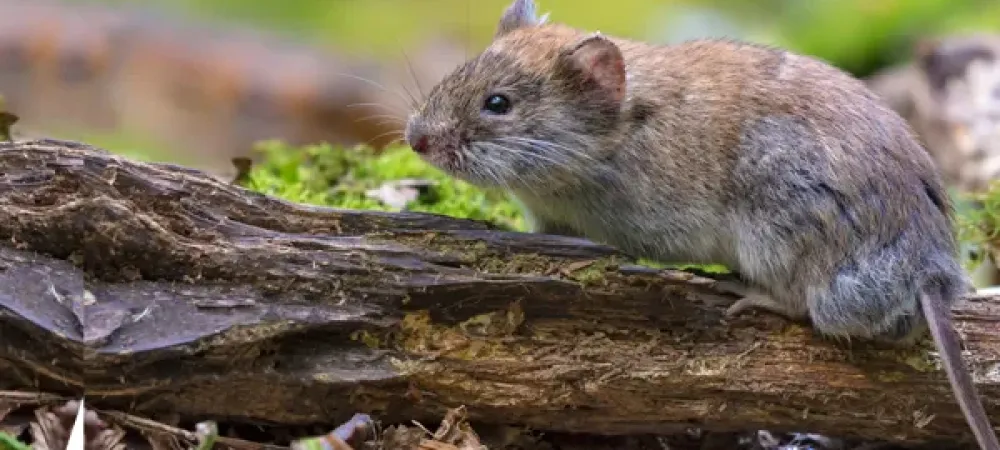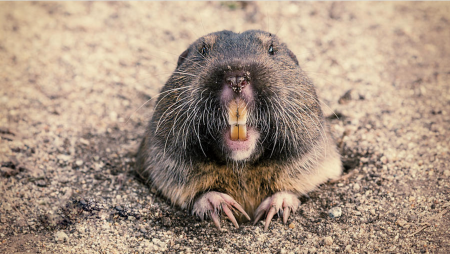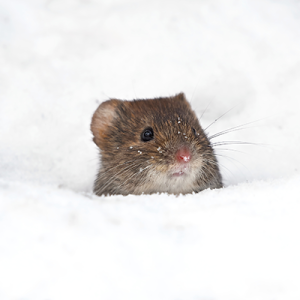What's The Difference Between Moles vs Voles?

While moles and voles might seem similar at first glance, they have distinct characteristics and behaviors that set them apart. In this comprehensive guide, we'll delve into the world of moles and voles, helping homeowners identify these pests and understand how to manage them effectively.
How To Identify Moles

Moles are small mammals belonging to the Talpidae family. They are expert diggers, equipped with powerful forelimbs and sharp claws perfectly suited for tunneling through soil. Moles are often solitary creatures, preferring to spend their time underground in elaborate tunnel systems. These tunnels serve as their homes, providing protection from predators and easy access to their favorite food: earthworms, grubs, and other soil-dwelling insects.
What Do Moles Look Like?
Moles have cylindrical bodies, velvety fur, small eyes, and powerful forelimbs with sharp claws. They typically measure about 5 to 8 inches in length and have short tails. Their fur can vary in color from light brown to dark gray, depending on the species and geographic location. Moles are well-adapted for a subterranean lifestyle, with specialized features such as reduced eyesight and powerful digging claws.
The body weight of moles can vary depending on the species, but on average, moles weigh between 2 to 6 ounces (approximately 56 to 170 grams). Some larger species of moles may weigh up to 7 or 8 ounces (approximately 200 to 227 grams).
When Are Moles Active?
Moles are primarily nocturnal, meaning they are most active during the night. They spend the majority of their time underground, constructing tunnels and foraging for food such as earthworms, grubs, and insects. While moles may occasionally surface during the day, especially in moist or overcast conditions, they generally prefer to avoid direct sunlight and are more active during the darker hours.
Do Moles Hibernate?
Moles do not hibernate. Instead, they remain active throughout the year, including during the winter months. However, their activity patterns may vary depending on factors such as soil conditions, food availability, and temperature. In colder regions, moles may dig deeper tunnels or seek out warmer areas underground during periods of extreme cold, but they continue to forage for food and maintain their tunnel systems year-round.
What Do Moles Eat?
Moles are carnivorous mammals that primarily feed on insects and other invertebrates found in the soil. Their diet typically includes:
- Earthworms: Moles are particularly fond of earthworms and will actively hunt for them in the soil.
- Grubs and larvae: Moles also consume beetle grubs, moth larvae, and other soil-dwelling insect larvae.
- Insects: They feed on a variety of insects, including ants, centipedes, spiders, and millipedes.
- Small vertebrates: Although less common, moles may occasionally consume small vertebrates such as frogs, mice, and shrews.
Moles can actually consume up to 60% to 100% of their body weight in insects, grubs, and earthworms each day.
Are Moles Blind?
Moles are not blind, but their eyesight is poorly developed due to their subterranean lifestyle. They have small eyes and reduced visual acuity, which is more adapted to sensing changes in light rather than forming clear images. However, moles compensate for their limited vision with other highly developed senses, such as their keen sense of smell and touch. They use their sensitive snouts and whiskers to navigate underground tunnels and detect prey.

Voles, also known as meadow mice or field mice, belong to the Microtus genus within the rodent family. They have stocky bodies, short legs, and short tails, resembling small mice. Unlike moles, voles are active both above and below ground, often creating visible surface runways through vegetation. Voles are herbivores, feeding on a variety of plants, including grasses, bulbs, and tree bark. They are known to cause damage to plants by gnawing on roots, stems, and bark, and they create shallow burrow systems with multiple entrances.
What Do Voles Look Like?
Voles resemble small mice with stocky bodies, short legs, and short tails. They typically measure about 3 to 7 inches in length, including their tails. Voles have small eyes and ears relative to their body size. Their fur can vary in color from brown to gray, with some species exhibiting lighter underbellies. While voles may resemble mice at first glance, they have distinguishing features such as shorter tails and stockier builds.
Voles are generally smaller than moles, with an average body weight ranging from 1 to 2 ounces (approximately 28 to 56 grams). However, like moles, vole body weight can vary depending on the species and geographic location.
When Are Voles Active? - Accordion
Voles are diurnal, meaning they are active during the day and rest at night. They can often be seen foraging for food, building nests, and traveling along their surface runways during daylight hours. Voles are opportunistic feeders, consuming a variety of plant material such as grasses, bulbs, and tree bark, and their above-ground activity makes them more visible to homeowners compared to moles.
Do Voles Hibernate?
Voles do not hibernate either. Like moles, they remain active throughout the year, including during the winter months. However, their activity levels may decrease during periods of extreme cold or heavy snowfall. Voles are adapted to cold climates and are capable of surviving harsh winter conditions by seeking shelter in their burrow systems and relying on stored food reserves.
What Do Voles Eat?
Voles are herbivorous rodents that primarily feed on plant material. Their diet varies depending on the species and the availability of food, but it commonly includes:
- Grasses: Voles consume a variety of grasses, including lawn grasses, meadow grasses, and agricultural crops.
- Bulbs and roots: They feed on the bulbs and roots of plants such as tulips, daffodils, and other garden plants.
- Tree bark: In winter when other food sources are scarce, voles may gnaw on the bark of trees and shrubs for sustenance.
- Seeds and grains: Voles also consume seeds, grains, and other plant materials found in their habitat.
Are Voles Blind?
Voles have relatively good eyesight compared to moles. While their vision may not be as acute as that of some other mammals, voles rely on their eyesight to navigate above-ground environments and locate food sources. Their eyes are larger relative to their body size compared to moles, and they are capable of distinguishing shapes and movements in their surroundings.

What Does Mole Damage Look Like?
- Molehills: One of the most recognizable signs of mole activity is the presence of molehills, which are small conical mounds of soil that surface when moles excavate their tunnels. These molehills can vary in size depending on the depth of the tunnel and the amount of soil displaced.
- Surface Tunnels: Moles create shallow tunnels near the soil surface as they search for food such as earthworms and grubs. These tunnels may appear as raised ridges or lines in the lawn and can disrupt the root systems of grass and plants.
- Damage to Plant Roots: While moles primarily feed on insects and other invertebrates, their tunneling activity can indirectly damage plant roots by disturbing the soil and causing root exposure. This can lead to wilting, yellowing, or stunted growth of grass and plants in affected areas.
What Do Mole Tunnels Look Like?
Mole tunnels typically consist of a network of interconnected passageways that moles use for shelter, nesting, and foraging. There are two main types of tunnels created by moles:
- Surface Runways: These are shallow tunnels that run along the surface of the ground, often appearing as raised ridges or lines in the lawn. Surface runways are used by moles to search for food near the soil surface, such as earthworms and grubs. They may also be used for travel between different areas of the mole's territory.
- Deep Burrows: These are deeper tunnels that moles dig underground for nesting and protection. Deep burrows can extend several inches to several feet below the surface and may include chambers for sleeping, storing food, and raising young. These tunnels are typically not visible from the surface and are used by moles to avoid predators and extreme weather conditions.
How To Get Rid of Moles
- Trapping: Humane mole traps, such as scissor or harpoon traps, can be effective in capturing and removing moles from the yard. Place traps near active tunnels or molehills for the best results.
- Repellents: There are various mole repellents available on the market, including castor oil-based products and ultrasonic devices. While repellents may not provide complete elimination, they can help deter moles from certain areas.
- Habitat Modification: Reduce the attractiveness of your yard to moles by minimizing water sources, removing dense vegetation, and maintaining a well-drained lawn. Moles prefer moist soil and abundant food sources, so creating less favorable conditions can help discourage their presence.
- Natural Predators: Encourage natural predators of moles, such as owls, hawks, and snakes, by providing habitat and food sources. Installing bird feeders or nesting boxes can attract these predators to your yard.
- Professional Assistance: In severe cases or persistent mole infestations, consider seeking assistance from a professional pest control service. They can assess the extent of the problem and implement targeted control measures.
Vole Yard Damage
- Gnaw Marks: Voles are herbivorous rodents that may cause damage to plants by gnawing on the bark, stems, and roots of trees, shrubs, and garden plants. They leave behind distinctive tooth marks on affected plant material, which can be seen upon close inspection.
- Damage to Bulbs and Tubers: Voles feed on the bulbs, tubers, and underground parts of plants such as tulips, daffodils, and potatoes. They may dig up these plant parts from the soil surface or tunnel underground to access them.
- Surface Runways: Voles create shallow surface runways or pathways through vegetation as they move about their habitat in search of food and shelter. These runways may appear as narrow paths or trails with flattened vegetation along their route.
What Do Vole Tunnels Look Like?
Vole tunnels, also known as runways or surface trails, are shallow pathways created by voles as they move through vegetation and grassy areas. These tunnels have distinct characteristics:
- Above-Ground Runways: Vole tunnels are typically visible above the ground as narrow paths or trails through grass, mulch, or other vegetation. They may appear as well-worn pathways with flattened vegetation on either side.
- Short and Narrow: Vole tunnels are narrower and less extensive compared to mole tunnels. They are often only a few inches wide and may follow the contours of the landscape.
- Entrance Holes: Vole tunnels may have small entrance holes leading to underground burrows. These burrows are used for nesting, shelter, and protection from predators.
How To Get Rid of Voles
- Exclusion Barriers: Protect vulnerable plants and garden beds from voles by installing fencing or hardware cloth around the perimeter. Bury the barrier several inches underground to prevent voles from burrowing underneath.
- Trapping: Live traps baited with peanut butter, apple slices, or grains can be effective in capturing voles without harming them. Place traps along vole runways or near their burrow entrances for the best results.
- Habitat Modification: Reduce vole habitat by removing dense vegetation, mulch, and debris from the yard. Keep grass and vegetation trimmed short to minimize hiding spots and nesting sites.
- Natural Predators: Encourage natural predators of voles, such as cats, dogs, owls, and snakes, to frequent your yard. Providing habitat and food sources for these predators can help keep vole populations in check.
- Repellents: Consider using vole repellents, such as garlic-based sprays or predator urine, to deter voles from certain areas of your yard. Apply repellents according to the manufacturer's instructions for best results.
Overview: Moles vs Voles
Homeowners can distinguish between moles and voles by considering several key factors:
Appearance:
- Moles have cylindrical bodies, velvety fur, small eyes, and powerful forelimbs with sharp claws. They typically measure about 5 to 8 inches in length and have short tails.
- Voles have stocky bodies, short legs, and short tails, resembling small mice. They typically measure about 3 to 7 inches in length, including their tails.
Feeding Habits:
- Moles are carnivorous mammals that primarily feed on insects and other invertebrates found in the soil, such as earthworms, grubs, and insects.
- Voles are herbivorous rodents that primarily feed on plant material, including grasses, bulbs, tree bark, and seeds.
Activity Patterns:
- Moles are primarily nocturnal and spend most of their time underground in elaborate tunnel systems. They are active during the night and may occasionally surface during the day.
- Voles are diurnal and are active during the day, foraging for food and traveling above ground. They may also create surface runways through vegetation.
Damage:
- Mole damage is characterized by the presence of molehills, surface tunnels, and disruption of plant roots. They primarily damage lawns and gardens through their tunneling activity.
- Vole damage includes gnaw marks on plant material, damage to bulbs and tubers, and visible surface runways through vegetation. They primarily damage garden plants and landscaping.
Professional Pest Control
If you need help identifying if you have moles or voles in your yard, look no further than Affinity Pest Control. Our team of local experts in Boise, ID, is here to provide professional inspections and offers gopher and vole removal services. Contact our team to learn more today!